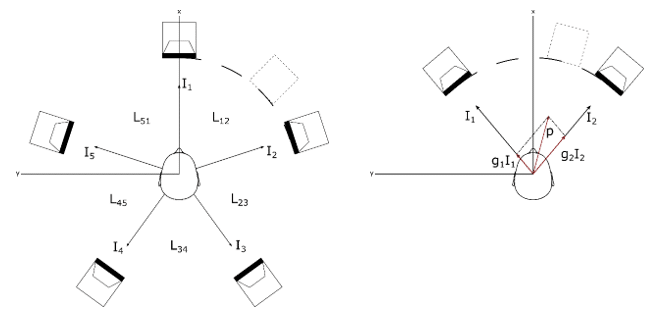Amplitude panning distributes a monophonic signal to a set of loudspeakers using frequency-independent gain factors. The weighted signals produce a virtual source in the desired direction. We will discuss vector-base amplitude panning (VBAP), specifically two-dimensional and three-dimensional.
Consider two loudspeakers equidistant from the listener, symmetric about the median at an azimuthal angle . A virtual source is perceived by adjusting the relative amplitudes of the loudspeakers. The virtual source is restricted to the
, allowing the listener to localize the auditory event on the active arc, an imaginary arc connecting the pair of loudspeakers. The strength of each loudspeaker signal is controlled by the gain factors,
. The basis is composed of unit-length vectors directed towards the virtual source,
where is matrix transposition,
are the gain factors, and
are unit vectors. In order to solve for the gain factors, we take advantage of the above equation in matrix form,
Using the right inverse of the matrix L, we solve for g,
It is also advantageous to normalize the factors:
where C is a specified value representing constant power.
Three-dimensional VBAP has a similar derivation but requires three loudspeakers to produce a virtual source. The approximated virtual source is projected on a sphere called the active triangle. This periphonic setup requires three gain factors normalized,
The gain factors are computed using the same technique,
VBAP also has a few interesting properties. When a virtual source is in the same direction as a loudspeaker, only the loudspeaker in the identical direction radiates the signal, i.e., the gain factor is one. An analogous experience occurs when the virtual source direction intersects a line connecting a pair of speakers. The gain factor is equal in each loudspeaker. Lastly, projecting the virtual source in the center of an active triangle ensures the gain factors of loudspeakers are equal.
Both setups are also allowed to have more than loudspeakers required within the respective active regions. This extension allows for moving sources within a plane or spherical surface. As seen in the image below, the loudspeaker uses multiple active regions. The only requirement is the active regions must not overlap. This limits the auditory event to the pair or triplet active arc or triangle, respectively. In other words, the signal is only heard through at most two or three loudspeakers for each VBAP dimension

perceived virtual source. (Left) Pantophonic configuration
with multiple active arcs. (Top) Stereophonic configuration
where p is the virtual source vector.